Just curious about a Mcmillan 50LBR or 50HBR stock for a long range heavy gun stock. I dont think i have seen all that many being used at the shoots i attend. I am kinda wondering if there might be a reason for that? If anyone has, or has had one of these stocks, please share the pros and cons, or personal opinions pertaining to this stock. I am kinda thinking about a project again, that i have often wondered about. Thanks Lee
You are using an out of date browser. It may not display this or other websites correctly.
You should upgrade or use an alternative browser.
You should upgrade or use an alternative browser.
Heavy gun stocks
- Thread starter skeetlee
- Start date
Karl Hunstiger
Club Coordinator
They work fine for me.
My answer is for the 70+ pound 1,000 yard stocks. I believe the 600 yard sorts don't make such heavy rifles; they shoot 6mms.
The McMillan 50-cal stocks work fine. Close to half of of the North Carolina 1,000 yard shooters use one on their Heavy Gun. What I used before building the tension-barrel tube guns. Almost every one who uses one uses the heavy stock, with the 7-inch wide forearm as a starting point.
Other options:
A number of N.C. and Virginia shooters use a wood stock, considerably cheaper. I believe the stocker's name was Miller. Johnny Byers in Wilksboro, NC is making them now as well, I believe. Maybe someone who knows about either of these will reply.
Bill Shehane has a line for the HGs too. At one time, he was building a stock that had a barrel block built in. Don't know if he still offers it.
Most people add a front plate and rear plate with some kind of guiderails to the stock.
Making your own is always a possibility. Aluminum, plywood, whatever. The only stock rule in 1K is, well, there aren't any.
Edit: Should have added Bruce Baer in Pennsylvanis. There are a number of people who make stoks for 1K Heavy Guns.
Here is an old link that shows some of the variations.
http://www.6mmbr.com/gunweek057.html
Typical 6mmBR.com BS, I include it for the pictures.
But to answer your question directly, there is nothing wrong with the McMillan 50s
The McMillan 50-cal stocks work fine. Close to half of of the North Carolina 1,000 yard shooters use one on their Heavy Gun. What I used before building the tension-barrel tube guns. Almost every one who uses one uses the heavy stock, with the 7-inch wide forearm as a starting point.
Other options:
A number of N.C. and Virginia shooters use a wood stock, considerably cheaper. I believe the stocker's name was Miller. Johnny Byers in Wilksboro, NC is making them now as well, I believe. Maybe someone who knows about either of these will reply.
Bill Shehane has a line for the HGs too. At one time, he was building a stock that had a barrel block built in. Don't know if he still offers it.
Most people add a front plate and rear plate with some kind of guiderails to the stock.
Making your own is always a possibility. Aluminum, plywood, whatever. The only stock rule in 1K is, well, there aren't any.
Edit: Should have added Bruce Baer in Pennsylvanis. There are a number of people who make stoks for 1K Heavy Guns.
Here is an old link that shows some of the variations.
http://www.6mmbr.com/gunweek057.html
Typical 6mmBR.com BS, I include it for the pictures.
But to answer your question directly, there is nothing wrong with the McMillan 50s
Last edited:
Thank you Charles, just the info i was looking for.
Charles,
On the all metal stocks. Will the metal have any problems with vibrations, or dampening of the vibrations from big boomer 1000 yard chamberings? Seems like we use wood and synthetic materials for the dampening effects in most all other rifle designs. any thoughts on this? Thanks again. lee
Charles,
On the all metal stocks. Will the metal have any problems with vibrations, or dampening of the vibrations from big boomer 1000 yard chamberings? Seems like we use wood and synthetic materials for the dampening effects in most all other rifle designs. any thoughts on this? Thanks again. lee
Last edited:
. . On the all metal stocks. Will the metal have any problems with vibrations, or dampening of the vibrations from big boomer 1000 yard chamberings? Seems like we use wood and synthetic materials for the dampening effects in most all other rifle designs. any thoughts on this?
No problems with metal. Put it this way. There are two differences between a 1K Heavy Gun and a point-blank rail gun.
The first is that the front and rear pedestals cannot be conjoined when you shoot. If you look at that web site, you'll see what appear to be one-piece rests. They are, but there is a plate holding the front and rear together. Before you start shooting, you take that plate off. Now the front and back aren't conjoined.
The second difference is the rifle must run on sandbags, not (say) V-blocks and delrin. If your rifle doesn't return to battery 80% of the time, you're not set up right. The difference lies in the fact that you have to look, and maybe adjust, after each shot. There is always that 10-20 percent chance the rifle didn't quite "return to battery." Though in fact, in order to shot as fast as possible, you sometimes ignore the little bit you're off. Depends on how bad the wind is and how far off you are.
OK. What are the most common materials used building point-blank rail guns? Steel and aluminum, right?
* * *
What first attracted me to 1,000 yard benchrest was the lack of equipment rules. There are a lot of "that won't work" notions in point-blank BR, I guess passed down from one generation to the next. Since they ran contrary to some rule or other, apparently nobody ever tried them, because in fact, many work just fine.
The Cass brothers, for example, had Light Guns where the "forearm" was a plate that clamped to the barrel, very similar to the "forearm" Gene Begs now uses in his ultralght stock. The rear "butt" on the Cass design was a small plate bolted to the bottom of the action. Except for the pound the scope weighted, and probably another pound for those front and rear "plates," everything else in the 17-pound rifle was the barrel, and a plain Winchester model 70 action. The Cass's won a lot...
While on them, their HGs weighted abut 180 pounds, and were chambered in 6mm/06. All metal designs. That 6/06 would send 107-grain Sierrra's off about 3,600 fps. So much for the notion that 6mms won't shoot over 3,000 fps -- or any particular number. As long as the bullet will hold together, and you can keep going up in powder, you'll likely find another speed they'll shoot at.
Anyway, they'd set the rifle up and fire about 5 shots as fast as they could. The rifle recoiled about an inch or so with each shot. After each shot, they didn't bother pushing the rifle back until they were running out of room on the bags -- usually about shot 5, so they'd only have to push the rifle back once. Talk about shooting fast -- a little over one second per round.
Oh yeah. Those HGs won a lot, too. Now that goes against the statement attributed to Bruce Baer in that 6mBR piece. 180 pound rifle that recoils about an inch, and shoots like a bat out of hell. Using a model 70 action. The Casss brothers only shot 4-5 years, but they're about middle of the pack among the 60 or so people who have achieved the IBS Long Rang Marksman jacket.
Speaking of that 6mmBR.com article -- they talked aout the tensioned barrled rifles I & some others were making (Charles Bailey was the first at our range, but the idea is so old, it had been patented. The patent had long run out by 1995.) Anyway, the 6mm BR.com article got how they are built wrong -- most, including the one pictured, use jacking screws, not a nut (though I've done that, too). And the point was not to lessen vibrations per se., but to move towards a double-cantileverd beam system. In other words, wherever the low-harmonic vibration's are moving things a lot, it ain't at the muzzle.
Etc.
With everything that's been tried, and worked, I get terribly hesitant saying, at least about a general system, "that won't work." It probably will. As always, the devil's in the details.
Last edited:
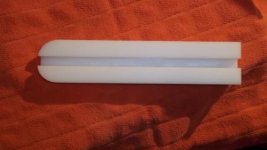
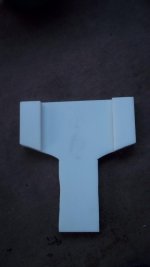
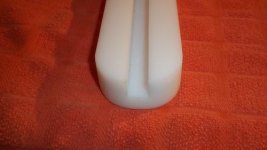
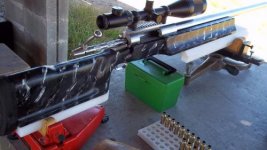
Skeetlee
The only problem with the McMillan 50 caliber stocks is that they need tracking rails added to them.If you don't add tracking rails your gun will tilt as you work the bolt because the bags squish up in the center.You could use two smaller "L" shaped bags to keep the sand in place but the wide rails really stabilize the gun.
You can drive down to any Tap Plastics store and have them build you HDPE or Delrin rails.The front rail pictured is 18 inches wide and two inches thick.I use double sided carpet tape to align it on the stock then drill it out and add some stainless steel screws to secure it.
On the rear it is 1 inch thick and has a channel to help prevent bag thickening from tilting it.I don't remember the cost of the front rails as I bought a full sheet of HDPE to play with adding $500 to the bill but the rear rails ran $54 for 3 guns or $18 each.
When I get the front rails perfected I take them back to Tap Plastics and they use my design as a pattern.
They are dirt cheap but they don't add much weight.
Lynn
Lynn
with that type of stock can i use say a 1.500 round action or will i have to have a bugger action to work properly? I had a fella contact me via PM and he was sharing some trouble he had with a 1.470 action in a stock such as the mcmillan 50. Any thoughts on that aspect? Thanks Lee
with that type of stock can i use say a 1.500 round action or will i have to have a bugger action to work properly? I had a fella contact me via PM and he was sharing some trouble he had with a 1.470 action in a stock such as the mcmillan 50. Any thoughts on that aspect? Thanks Lee
SkeetLee
The big McMillan stock is designed for the 2 inch McMillan 50 Caliber Action commonly called the McBros Action.As it is intended for a 2 inch action using a Remington in it means you need to cycle the bolt with some enthusiasm for the cases to clear the stock properly.I don't care for actions that throw the cases out weakly and naturally you need a bolt handle of decent length.If you use a short bolt handle it is almost in the stock when in the closed position.
I have been asking for longer handles for years now.
Lynn
The big McMillan stock is designed for the 2 inch McMillan 50 Caliber Action commonly called the McBros Action.As it is intended for a 2 inch action using a Remington in it means you need to cycle the bolt with some enthusiasm for the cases to clear the stock properly.I don't care for actions that throw the cases out weakly and naturally you need a bolt handle of decent length.If you use a short bolt handle it is almost in the stock when in the closed position.
I have been asking for longer handles for years now.
Lynn
Last edited:
A lot of people use 700s in the big McMillan stocks. But they are sleeved. And yes, they have a longer bolt handle fitted.
If you're not going to use a heavy barrel -- 1.5 or so in diameter, there is no need for the Big Mac. If you're going to use a 1.5 inch barrel with the 700, it better be barrel blocked. The one time I can think of where both a sleeve and a block might be needed.
If you're going to use an unsleeved 700 and a block, you'd be better off to just get a Miller or Byers wood stock. A lot cheaper, and they've done a lot of winning.
Actually, IIRC, Jamie Cass once just mounted his barreled action to a 4x4. He used an Uncle Bud's Bull Bag for a rest. Can't remember if that was his setup when he (briefly) held the IBS 1K group record...
If you're not going to use a heavy barrel -- 1.5 or so in diameter, there is no need for the Big Mac. If you're going to use a 1.5 inch barrel with the 700, it better be barrel blocked. The one time I can think of where both a sleeve and a block might be needed.
If you're going to use an unsleeved 700 and a block, you'd be better off to just get a Miller or Byers wood stock. A lot cheaper, and they've done a lot of winning.
Actually, IIRC, Jamie Cass once just mounted his barreled action to a 4x4. He used an Uncle Bud's Bull Bag for a rest. Can't remember if that was his setup when he (briefly) held the IBS 1K group record...
Last edited:
Been giving this some thought. Are your questions just another one of your Saturday morning fantasies, or are you seriously building a 1,000 yard Heavy Gun? I have a reason for asking. A lot of aspects of any build are compromises. Not due to lack of money, or time, or skill -- though those can be a factor -- but due to other decisions.
So if you just want general information to tuck away, I'm going to sit the discussion out, not only because it is a waste time, but the information given assumes certain things have been decided. If they have not, the answers may well be wrong. By "wrong" I mean not the best compromise. Any competitive rifle is a system, and "best" component is a relative term.
***
Edit
I'll give you a personal example. At my stage of development as a long-range shooter, I decide what rifle to build based first on powder, second on caliber. I do not want to build a rifle that depends on a very slow powder such as on Reloader R-22 or R-25, nor H-1000, etc. I will build it based on using H-4350, or H-4831. Now using these powders, there are several calibers I can choose from, but for any particular caliber, certain chamberings are ruled out, and certain appear to offer better prospects. Etc.
I may decide that I'm wong in this series of choices. That is, 5 years from now, I may pick a differfent starting point. Right now, with 15-years experience, it is where I am in my devlopment. For now, other decisions have to be made on first having made powder and cailber decisions.
So if you just want general information to tuck away, I'm going to sit the discussion out, not only because it is a waste time, but the information given assumes certain things have been decided. If they have not, the answers may well be wrong. By "wrong" I mean not the best compromise. Any competitive rifle is a system, and "best" component is a relative term.
***
Edit
I'll give you a personal example. At my stage of development as a long-range shooter, I decide what rifle to build based first on powder, second on caliber. I do not want to build a rifle that depends on a very slow powder such as on Reloader R-22 or R-25, nor H-1000, etc. I will build it based on using H-4350, or H-4831. Now using these powders, there are several calibers I can choose from, but for any particular caliber, certain chamberings are ruled out, and certain appear to offer better prospects. Etc.
I may decide that I'm wong in this series of choices. That is, 5 years from now, I may pick a differfent starting point. Right now, with 15-years experience, it is where I am in my devlopment. For now, other decisions have to be made on first having made powder and cailber decisions.
Last edited:
Charles
I really dont know how to answer your question. I have thought about having a Heavy gun 1000 yard gun for a couple years now. Were my hesitations lye, is that i will only attend one maybe two shoots each year. I like point blank first and foremost, and i dont see that changing anytime soon.
I have a group of good friends that i really enjoy being around and they are long range junkies. I like to attend a couple shoots a year with them.
I have a couple rifles for sale, and when one of them sales, i thought i would start buying some pieces for this build. I am not real sure i can buy everything i need right away, but i am going to start my selections for this project soon. So I wouldn't call this a Saturday morning question, i would call it more along the lines of i need some education before i spend some good money the wrong way question. I hope to have this project completed by this summer, but i cant be sure of this either.
Charles, I always enjoy reading what you have to say, so if you care to share please do so. If you feel a phone call would be best, i would gladly call you. Long range shooting, and long range gear is definitely a weak subject for me. I am addicted to one hole groups and light recoiling rifles, so i haven't ever really educated myself in this long range discipline. If i thought a 6mmDasher would compete at 1000 yards that is what i would like to build. There again, i dont even know if a dasher would be a good choice in a Heavy gun? My 17lb 600 yard rifle is a dasher, and i plan to shot it this year for 1000 yards LG class. I know a lot of folks shoot a dasher, but i would have to think there are better chamberings for the 1000 yard game over all?? So thats the scoop. I have a rifle for just about every game i think i will ever play, except for 1000 yards. Lee
I really dont know how to answer your question. I have thought about having a Heavy gun 1000 yard gun for a couple years now. Were my hesitations lye, is that i will only attend one maybe two shoots each year. I like point blank first and foremost, and i dont see that changing anytime soon.
I have a group of good friends that i really enjoy being around and they are long range junkies. I like to attend a couple shoots a year with them.
I have a couple rifles for sale, and when one of them sales, i thought i would start buying some pieces for this build. I am not real sure i can buy everything i need right away, but i am going to start my selections for this project soon. So I wouldn't call this a Saturday morning question, i would call it more along the lines of i need some education before i spend some good money the wrong way question. I hope to have this project completed by this summer, but i cant be sure of this either.
Charles, I always enjoy reading what you have to say, so if you care to share please do so. If you feel a phone call would be best, i would gladly call you. Long range shooting, and long range gear is definitely a weak subject for me. I am addicted to one hole groups and light recoiling rifles, so i haven't ever really educated myself in this long range discipline. If i thought a 6mmDasher would compete at 1000 yards that is what i would like to build. There again, i dont even know if a dasher would be a good choice in a Heavy gun? My 17lb 600 yard rifle is a dasher, and i plan to shot it this year for 1000 yards LG class. I know a lot of folks shoot a dasher, but i would have to think there are better chamberings for the 1000 yard game over all?? So thats the scoop. I have a rifle for just about every game i think i will ever play, except for 1000 yards. Lee
It is still hard to know how to respond. A 17-pound Dasher is capable of winning a 1,000 yard Heavy Gun match, for either group or score.
Pretty much all that's available to you will be shot under the IBS sanction, unless you go to Pennsylvania (and you should go there, at least once).
Here is a site that shows all the IBS the match results
http://internationalbenchrest.com/results/long_range/index.php
Now equipment lists are horribly unreliable, but they're not ALL wrong. At Carolina, the information on Thomas Ellington is correct. He shoots a Dasher in both Light and Heavy Gun, and he's also done a lot of winning.
Here is a link to a recent Carolina match
http://internationalbenchrest.com/results/long_range/2011/NC1000/Matches/M9.php
If you go to a West Virginia club, you'll see a lot of the smaller chamberings used:
http://internationalbenchrest.com/results/long_range/2011/White Horse/924/WhiteHorse924.php
Obvisouly , 1K, or even 600 yards, is not like point-blank: there is no single dominant chambering. So here's the first question: As you are familiar with the Dasher, why do you want to build something different? If you do, you should build it, but be honest with yourself.
Once you know what you're going to build, you can pick other components, with an eye on your budget. If you want another Dasher, there is absolutely nothing wrong with a BAT B153R; There is also no need for it.
On the other hand, if for some reason -- and there are good ones -- you want a big 30 or a small .338, different actions are called for.
All of that will affect your stock choice.
Now, I'm not a small caliber afficianado. I shoot .30s and .338s. My choices are neither right, nor wrong. Thomas Ellington has more lifetime points than I (well, he also goes to more matches...). Pennsylvania Shooters like Mark King and Jason Baney (6 BR, actually) will use a Dasher and clean your clock, pretty much every time.
What, if anything, is the secret to 1K shooting? Preparing your ammunition. Much more important in long range than with point-blank. Preparing your ammunition will require some tooling you probably don't have. Do you want it available for point-blank shooting, or do you want to keep the two completely separate. Good reasons for either choice.
I really ought to mention that a number of short-range shooters do not enjoy long range. You can't see you shots, for one thing. I think long range is more about educated instincts than calculation. Well, at the highest level, short-range is instinctive too, but it's still different. So before laying out a significant amount of money, why not see if you are going to enjoy it?
If you want to own and shoot a big gun, say a .30, this is a good place for it. Just allow that there is an emotional component to that decision and don't look back. If there is no such emotional involvement, use the match reports of the ranges near you to see what the winners use, and build that.
BTW, Thomas Ellington does use the Big Mac with his Dasher... I see the match result I posted wasn't one of his better days. Here's one from a year earlier where he won both his Light and Heavy gun relays, and the HG match to boot.
http://internationalbenchrest.com/results/long_range/2010/Butner/M10.htm
Nothing special about Thomas as a Dasher shooter -- You can find the same thing at most any club. I use him as an example because I've shot against him for so many years. If you decide on a Dasher, there are many better people to get help from than me.
Pretty much all that's available to you will be shot under the IBS sanction, unless you go to Pennsylvania (and you should go there, at least once).
Here is a site that shows all the IBS the match results
http://internationalbenchrest.com/results/long_range/index.php
Now equipment lists are horribly unreliable, but they're not ALL wrong. At Carolina, the information on Thomas Ellington is correct. He shoots a Dasher in both Light and Heavy Gun, and he's also done a lot of winning.
Here is a link to a recent Carolina match
http://internationalbenchrest.com/results/long_range/2011/NC1000/Matches/M9.php
If you go to a West Virginia club, you'll see a lot of the smaller chamberings used:
http://internationalbenchrest.com/results/long_range/2011/White Horse/924/WhiteHorse924.php
Obvisouly , 1K, or even 600 yards, is not like point-blank: there is no single dominant chambering. So here's the first question: As you are familiar with the Dasher, why do you want to build something different? If you do, you should build it, but be honest with yourself.
Once you know what you're going to build, you can pick other components, with an eye on your budget. If you want another Dasher, there is absolutely nothing wrong with a BAT B153R; There is also no need for it.
On the other hand, if for some reason -- and there are good ones -- you want a big 30 or a small .338, different actions are called for.
All of that will affect your stock choice.
Now, I'm not a small caliber afficianado. I shoot .30s and .338s. My choices are neither right, nor wrong. Thomas Ellington has more lifetime points than I (well, he also goes to more matches...). Pennsylvania Shooters like Mark King and Jason Baney (6 BR, actually) will use a Dasher and clean your clock, pretty much every time.
What, if anything, is the secret to 1K shooting? Preparing your ammunition. Much more important in long range than with point-blank. Preparing your ammunition will require some tooling you probably don't have. Do you want it available for point-blank shooting, or do you want to keep the two completely separate. Good reasons for either choice.
I really ought to mention that a number of short-range shooters do not enjoy long range. You can't see you shots, for one thing. I think long range is more about educated instincts than calculation. Well, at the highest level, short-range is instinctive too, but it's still different. So before laying out a significant amount of money, why not see if you are going to enjoy it?
If you want to own and shoot a big gun, say a .30, this is a good place for it. Just allow that there is an emotional component to that decision and don't look back. If there is no such emotional involvement, use the match reports of the ranges near you to see what the winners use, and build that.
BTW, Thomas Ellington does use the Big Mac with his Dasher... I see the match result I posted wasn't one of his better days. Here's one from a year earlier where he won both his Light and Heavy gun relays, and the HG match to boot.
http://internationalbenchrest.com/results/long_range/2010/Butner/M10.htm
Nothing special about Thomas as a Dasher shooter -- You can find the same thing at most any club. I use him as an example because I've shot against him for so many years. If you decide on a Dasher, there are many better people to get help from than me.
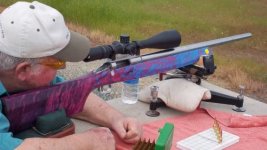
http://www.youtube.com/watch?v=MfHqzlCPgS8
SkeetLee
Here is a Williamsport shooter using a 6Dasher in heavygun.Note how far his empties fly when he retracts the bolt.If your action ejects properly the big McMillan will work just fine.
The picture above is of the(call sign)Cougar shooting one of my 6 Dashers at Ojai,Ca.That gun is capable of winning in heavygun anywhere and probably resembles most 600 yard lightguns including yours.
Build what YOU want and don't look back.
Lynn

